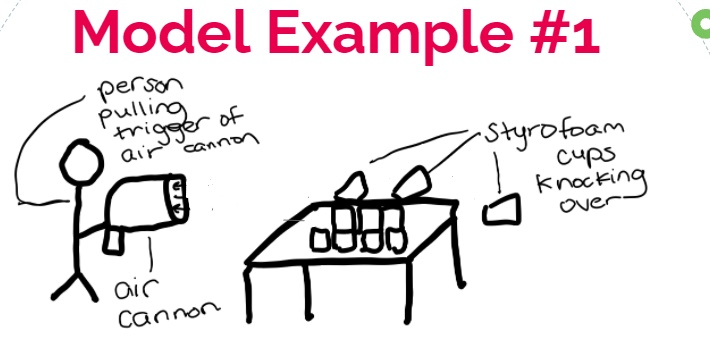Air is made up of ____________________?
What are small particles.
Backwards or towards yourself.
Which is the solid and which is the liquid from this investigation?
The solid was baking soda and the liquid was vinegar.
Did the balloon inflate or deflate in this investigation?
The balloon inflated.
Which had more mass, the deflated beach ball or the inflated beach ball?
The inflated beach ball had more mass.
Air takes up _________________?
What is space.

Arrows for movement.
What did the bubbles represent when the baking soda was mixed with the vinegar?
Small particles.
When the balloon filled up, what did this tell us about air?
That Air takes up space.
When weighed the deflated beach ball, then pumped it up and weighed it again on the schale, what did this investigation tell us?
That air has mass (or weight)
Air has _________?
Weight or Mass

Labels!
What sound did you hear when the baking soda mixed with the vinegar?
Arrows.
When I drew the model of the inflated beach ball, did I have arrows outside of the beach ball or inside of the beach ball?
Inside of the beach ball.
If you are drawing a model on Air movement, what three things do we need when we draw a model?
A picture, arrows for movement and labels.
This investigation helps prove which of the following?
a. Air takes ups space
b. Air is made up of small particles
c. Air has mass
C. Air has mass
What sense did you use when you heard the baking soda mixing with the vinegar: Quantitative or Qualitative?
Where was the movement in the flask after you our your group member lifted the balloon and the baking soda fell in it?
The movement went up, the gas traveled up into the balloon.
When we measured the weight of the deflated and inflated beach ball, was that Quantitative or Qualitative?
Blowing on your hand shows us that Air has?
Weight or mass
Ping pong balls
Did a chemical change or a physical change occur when we mixed the baking soda and vinegar?
A chemical change occured.
What occurred after you or your group member released the balloon from the flask?
The balloon either flew off, fell off but it did not stay attached to the flask.
When Mr. Augello held the meter stick with a deflated balloon on one end and a deflated balloon on the other, why did the inflated balloon slight go lower?
What are Nitrogen(78%), Oxygen(21%), Argon(.9%) and other gases (.1%)
Why wouldn't this experiment work exactly the same way if it was conducted on the Moon?
The moon doesn't have air and the gases on the moon are neon, helium and hydrogen which are lighter than the Earth's atmosphere.
What gas was created when mixing the baking soda and vinegar?
Carbon Dioxide.
What was the name of the flask used in this experiment?
The Erlenmeyer Flask.
How much more weight did the inflated beachball have than the deflated beachball?
Period 3: 0.2 grams
Period 4: 0.8 grams